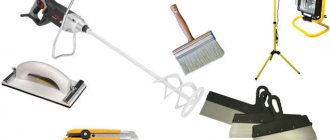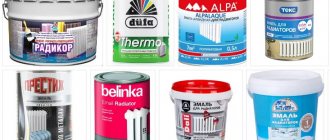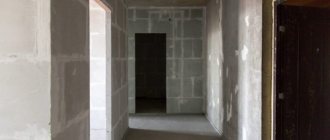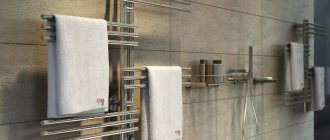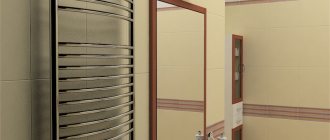Optimal installation height from the floor
Unfortunately, it is not always possible to adhere to SNiP standards. Sometimes the bathroom area is so small that it seems that there is no way to place additional equipment in it. However, if you approach it wisely, you will be able to ensure safe operation of the heating device.
The minimum mounting height for the coil is 95 cm. If the distance is less than this, installation is strictly prohibited. The maximum mounting height from the floor is 170 cm
However, using a heated towel rail installed at such a height is inconvenient. When it comes to installing a “ladder” coil, it is important to consider that a person must easily reach its highest point.
The M-shaped coil must be installed at a height of at least 90 cm.
The U-shaped coil is installed at a minimum height of 110 cm.
The main thing is to remember that the heated towel rail should be hung at a height that is convenient for use by all household members.
As for the placement of the coil next to other plumbing fixtures, for example, the “towel” should be located 60–65 cm from the radiator. The ideal distance from the wall should be 5–5.5 cm, although in a small bathroom this figure can be reduced to 3.5–4 cm.
Installation of the “towel-coil” must be carried out by highly qualified craftsmen. They adhere to GOST standards and know the acceptable nuances of indentation.
It is worth noting that in some institutions, for example in children's. gardens, individual requirements of GOST and SNiP apply. Firstly, it is not recommended to install electric coils in kindergartens. Secondly, the size of the heated towel rail for a child care facility should not exceed 40-60 cm. Thirdly, they must be mounted at a safe distance from children so that the kids do not get burned, but at the same time reach the hanging towels.
Level of sockets for connection
The installation of sockets and other electrical equipment is regulated by the requirements . The main aspect in this matter is human safety; the slightest possibility of electric shock must be excluded. It is advisable to entrust the installation to electricians, because the cost of wiring 1 point will not greatly affect the family budget.
A simple rule applies: the higher the socket is from the floor, the better and safer.
The optimal outlet level for a heated towel rail is 60 cm . This is enough to connect electrical equipment and eliminates the possibility of a short circuit in the event of a flood.
The installation of a heated towel rail must be carried out by specialists who comply with GOST standards in their work. If the heated towel rail is not installed according to the rules at the wrong height, it can cause subsequent leaks and other problems, including flooding of neighbors. Educational institutions, for example, kindergartens, have their own regulatory indicators.
Are there any requirements for the installation height of a heated towel rail above the floor?
There are certain SNiP standards that regulate the installation of equipment of this type, such as heated towel rails.
The heated towel rail must be installed at a distance of 120 cm from the floor level and must be at least 60 cm away from all nearby objects, such as a bathtub, sink, shower and other plumbing equipment.
In this case, the heated towel rail can be placed directly above the washing machine, and in such a way that it does not interfere with the free opening of the lid of a front-loading machine.
If a ladder-type heated towel rail is installed, it should be located at such a height that an adult can have free access to the top rail of the dryer.
There are no height requirements in any regulatory document; if I’m wrong, then indicate the document number and the chapter that says at what distance the heated towel rail must be installed from the floor.
There are only recommendations from specialists, and they mostly lead to two characteristics:
- Ease of use.
- Bath heating.
Although it is clearly stated everywhere that a heated towel rail is not a heating system, it is more designed to maintain the microclimate in a humid room such as a bathroom.
How much does a heated towel rail cost?
1. Water models are the cheapest, although everything here depends on the material of manufacture, the complexity of the design and the popularity of the brand. Steel costs between 750-195,000 rubles, stainless steel can cost one and a half million. The ceiling for copper appliances does not exceed 130 thousand rubles, for brass – 200 thousand with a minimum price of 2500 rubles.
2. Steel electric heated towel rails are presented in the price range from 1000 to 213 thousand rubles. (stainless steel is traditionally more expensive). For a copper model powered from the mains, you will have to pay from 16 to 80 thousand; brass costs exorbitant money - at least 10 thousand rubles, maximum 11 million.
3. The cost of combined stainless steel heated towel rails ranges from 3 thousand to 2 million rubles, ferrous metal will be three times cheaper. Brass station wagons start at 5,000 rubles and go up to 12 million.
Expert advice
If you decide to replace an old radiator with a modern product, you need to choose a battery with smooth contours that do not interfere with the coolant flow.
This alloy is characterized by high strength, presentable appearance, durability and corrosion resistance. It is recommended to install a Mayevsky valve during installation so as not to depend on neighbors when air enters the system.
Where can I complain about the cold?
If there is no coolant circulation or its temperature is insufficient, you must first contact the house management. If the cause of the problem is caused by the actions of the residents or the house plumber, then the problem must be repaired by authorized persons. When such an appeal does not produce results, you need to file a complaint with the heating network. If this does not help, you should contact the Consumer Rights Protection Committee.
How to disconnect and dismantle?
In an apartment building, you can turn off the radiator only if there is a bypass that ensures a continuous supply of water through the riser. Dismantling is carried out after shutting off the general water supply or with the tap closed. Unscrewing old products can be difficult. To make it easier to unscrew the nuts, the joints must be warmed well with a gas burner. If the joints are rusty, they are cut off, and subsequent connections are made using couplings.
At what height can a heated towel rail be hung?
After purchasing a device, many people have a question: at what height should the product be hung? There are general standards for carrying out such work, which state that the distance from the floor to the bottom of the device must be at least 1.2 meters.
For this reason, modern products are installed based on the following principles:
- Ease of use is the main installation criterion. A large device should be lowered down enough for the user to reach the top of the product.
- The heated towel rail should be located at least 0.6 m away from other objects in the room. This is done in order to avoid heating plastic structures, for example, a basket for dirty laundry.
- The minimum distance from the floor to the bottom of the device is 0.95 m, and if the pipes of the product are U- or M-shaped, then the distance increases to 1.1 m.
- Electrical appliances should be located at some distance from the heated towel rail.
However, it is not enough to simply find a place and hang the device correctly. Other requirements must also be met.
Fastening the heated towel rail in accordance with the standards
There are standards for installing water heated towel rails:
- The diameter of the main pipeline should not be larger than the diameter of the device.
- The distance from the wall to the center of the pipe should be 3.5–5.5 cm.
- The heated towel rail is attached to the wall using brackets.
- The connection to the pipe is made using couplings.
- The coolant must move strictly from top to bottom.
- The height to the floor according to the standards is 120 cm. The minimum permissible height is 95 cm.
- Distance from other objects – 60 cm.
USEFUL INFORMATION: How to calculate tiles for a bathroom: how many tiles should I buy?
Depending on the type of heated towel rail, before purchasing and installing, you need to consult with a plumber or electrician servicing your home. They will tell you what requirements the device must meet in order not to harm home communications.
Normal air humidity in a child's room
The optimal air humidity for a child in an apartment is determined based on his age
Compliance with this parameter is especially important for newborns:
- Features of thermoregulation in infants. The drier the air (which the child inhales), the more fluid the body will spend to hydrate it. This is associated with large losses of water - dryness of the mucous membrane of the nasopharynx and nasal cavity occurs, and it is difficult for the baby to breathe. As a result, he wakes up more often at night, eats poorly, and is capricious.
- Long heating season. In most Russian cities it lasts at least 6 months a year. Central heating radiators can reduce the initial humidity levels in a room by 20–40% or more. Low humidity during the heating season leads to frequent respiratory diseases, chronic rhinitis, and an increased risk of bronchial asthma.
Optimal humidity in a child's room is especially important.
Depending on the age of the child, it is determined what humidity should be in the bedroom. For children in the first year of life, the optimal parameter is 50–70%, for children from 1 to 3 years old – 45–65%, for children over 3 years old almost adult norms are suitable – 50–60%.
Installation of a combined model
Installing an electric heated towel rail requires special efforts. The main advantage of this installation is the continuous heating of the dryer at any time of the year. In addition, you can adjust the temperature here.
During the repair work, it is necessary to carry out additional wiring from the pipeline. This will save energy consumption in winter. At the end of the heating season, the electrical network is used.
The height of the heated towel rail from the floor should be from 65 to 100 cm. The higher the drying position for small items, the greater the heat transfer of the device.
As you can see, installing such a system requires special knowledge in the field of electricity. Photo installation instructions help to perform installation work correctly.
Overview of species
There are different types of water towel dryers. Such designs are divided into several different types according to certain characteristics. Let's take a closer look at them.
By shape
Modern models of water-type dryers can have various shapes. Let's find out what types of structures can be found on sale today:
- classic coils;
- ladder dryer;
- M-shaped heated towel rail;
- U-shaped;
- W-shaped;
- designer varieties of water dryers with non-standard shapes;
- models with a shelf in the design.
You can choose the perfect option for both the simplest and the most stylish and modern bathroom. All of the listed examples are highly convenient to use.
According to the material of manufacture
When choosing a specific model of water towel dryer, it is very important to pay attention to what material it is made of. The quality of the product, its service life, and quality characteristics depend on this parameter.
Plain steel
Such products are durable and quite practical. They are found in many homes. The main disadvantage of steel specimens is their susceptibility to corrosion. You can protect such a coil by applying high-quality paint of a suitable shade. In addition, the coloring composition must counteract the negative effects of moisture on steel.
Stainless steel
No less popular, but more practical and wear-resistant material. Stainless steel is not subject to corrosion, does not change its original shape and appearance, and therefore does not require additional protective manipulations by the owners. Stainless steel coils are one of the best in terms of price-quality ratio.
Stainless steel products are characterized by very good heat transfer. The downside may be corrosion caused by stray currents if the pipeline was used by someone as grounding. This is most often noticeable if boilers are used instead of a standard centralized hot water supply system.
Copper and brass
Excellent materials that are perfect for the production of water-type heated towel rails. Such structures operate without problems in conditions of high humidity levels. It is worth noting that copper specimens have no equal in terms of thermal output. Their main disadvantage is their very high price. In addition, over time, copper loses its former attractive shine and therefore requires constant care.
Aluminum
Thin-walled varieties of water dryers are also produced. These options are made from aluminum
In situations where special attention is paid to water pressure, such products often require the creation of an individual water supply system with suitable characteristics and parameters
By installation method
Modern models of water heated towel rails provide various types of fastening. Based on this parameter, the following types of products are distinguished:
- wall-mounted (models with wall-mounted installation are among the most popular);
- floor
Water towel dryer
In older homes, a heated towel rail is usually already installed in the bathroom. It is embedded in the heating system and looks like a snake. This is the most common design. If it is not in your apartment, then you can install it yourself.
The simplest design is U-shaped. It has only one rounding, and this option is the easiest to connect to pipes.
A modern version of the dryer is a “ladder”. It consists of two pipes connected by crossbars on which towels can be hung.
Some manufacturers offer designer products with unusual shapes. They perform their direct function and also serve as decoration for the bathroom interior. These designs are well suited to loft, hi-tech or constructivism styles. But they require proper connection to the water supply; not every master can handle this.
The shape of the device is selected according to the area of the bathroom and design. Since this device heats the room, you should not buy a product that is too large for a small room. Judging by the reviews, the “snake” or “ladder” shape is most often installed.
Types of heated towel rails
The construction market offers a wide range of this product. Everyone can choose the desired shape (coil, ladder version) and the material from which the heated towel rail is made: stainless steel or brass.
It is also advisable to choose a design with a minimum of seams, jumpers or without them and avoid possible leaks in the future.
When choosing a pipe, take into account the area of the room (5.5-6.5 sq. m) and the interior of the bathroom.
There are 3 types of heated towel rails:
- Water - heating occurs due to the circulation of hot water.
Popular models
When making renovations, owners of apartments and houses want to purchase not just a high-quality heated towel rail for their bathroom, but also a universal device that will fit into the overall design of the room. Experts advise giving preference to products from well-established manufacturers.
These include the German company Arbonia. One of the models of universal heated towel rails from this manufacturer is Karomix with a unique design and remote control. The range is wide in color, installation is easy, as is adjusting all parameters. Device power – 950 W, heat transfer power – +500 degrees.
Another manufacturer from Germany offers its universal Zehndler heated towel rails, which are popular among consumers. The range consists of 25 models of various shapes and sizes (more than 200). These devices can be used not only in the bathroom, but also in other rooms for additional heating. Such devices are produced from clean (from an environmental point of view) raw materials.
The Italian company Margaroli has been on the market for more than half a century and today offers its modern combined heated towel rails, which are available in various shapes for any design solution.
Let us also note the Russian one, the leader in the production of heated towel rails not only in the domestic market, but also in the CIS countries. The brand produces devices from economy class to premium category. Customers are also offered devices of various manufacturing technologies, for example, seamless heated towel rails made from pipes with a diameter of 1.8 millimeters. At the same time, they have a good service life, even at a water pressure of 8 atmospheres.
Another Russian one produces universal models of stainless steel heated towel rails. Under this brand you will find reliable products with an unusual design - for any bathroom with an extraordinary decor.
When choosing a particular model, be sure to read the information from the manufacturer and find out whether it is suitable for your heating system and electrical network.
How to determine the size of a product?
The size of the heated towel rail plays a decisive role in the choice of equipment
If you incorrectly calculate the dimensions, this will complicate installation and will not allow you to purchase equipment that will fully cope with the functions assigned to it. Experts advise taking into account the temperature of the coolant in the system. It is usually 70 degrees
This technology assumes that the ratio of the heated towel rail area to the bathroom area is 2.5 cubic meters/100 W. In addition, be sure to determine the installation location and add 10 centimeters on each side.
Features of installation of heated towel rails
The main parameter of a heated towel rail is its size. The heating capacity of the room and the number of towels placed on the product depend on it.
The size of the heated towel rail is selected based on the area of the bathroom. A large heated towel rail will not fit in a small room; a small one will not make sense in a spacious one. However, even an ideally selected heated towel rail size has placement features related to the type of connection.
Water heated towel rail
The functioning of a water heated towel rail depends on the central water supply or heating system. The height and type of connection of the heated towel rail must be calculated based on the location of the main communications.
Connecting a water heated towel rail can be:
- Lateral. Connection to the hot water riser on the left or right. When connected, it does not violate the integrity of the design, so it can be carried out after finishing work.
- Diagonal. Ensures good water circulation in the heated towel rail. This is especially true for systems with low pressure.
- Floor-standing. Relevant for spacious rooms where there is enough free space on the floor. Can use a collapsible connection system to the main pipe.
Electric heated towel rail
If you decide to buy an electric heated towel rail, pay attention to safety precautions when connecting it.
Installation of electric models does not require intrusion into the water supply system. But dependence on electricity imposes its own nuances. The location of the electric heated towel rail depends on the location of the waterproof socket.
What sizes of heated towel rails are there?
First of all, let us highlight the differences between plumbing fixtures based on their operating principle. There are three types of structures:
- electrical;
- water;
- combined.
The housing layout of apartment buildings involves installing a stainless steel heated towel rail in the bathroom and connecting it to a hot water supply or heating system (in old houses). Therefore, water-based plumbing fixtures are very popular. The simplicity of design and connection makes them popular. The peculiarity of the work is that the surface is heated only when hot water (heating) is turned on.
Electric heated towel rails are turned on in the required mode, and this allows you to be independent from the operation of the water supply. The complexity of the design makes the equipment expensive, which helps reduce demand.
A combined type heating device is installed if the consumer wishes to use two types of heating for greater operating efficiency.
dimensions
Since Soviet times, a prototype of a heated towel rail in the form of a coil of the same size has been developed. Progress does not stand still and, today, manufacturers of sanitary equipment offer a large selection of equipment for drying towels, which differ in shape and size. Externally, the devices are:
- M-shaped (conventional coils);
- U-shaped;
- ladders (with or without shelf);
- S-shaped;
- other designs.
These structures have different overall dimensions, both in height and width. Plumbing manufacturers try to maintain the standard height of the coils, which is used for the usual connection to the hot water riser, while the length and internal weave of the pipes are done in different ways. Other configurations of heated towel rails have no restrictions on dimensions, and if the consumer wishes, custom designs are made according to the specified dimensions.
The smallest plumbing fixture for drying towels has dimensions of 400x500 mm. Such a unit will be convenient for use in a small bathroom, or when installed as an additional heated towel rail.
Characteristic for devices that resemble a letter is the elongation of the structure. For example,
- M-shaped: height – 55 cm, length 50–120 cm;
- U-shaped, with a height of 30 cm, have a length of 50–90 cm.
For plumbing fixtures in the form of a ladder, more often, on the contrary, the height is greater than the length. For example, with a structure width of 50 cm, the vertical dimension ranges from 60 cm to 130 cm. At the same time, the width can also change.
When it comes to standard sizes, this means that the applicant for a plumbing fixture is talking about the accepted height for connecting to a hot water supply riser. It is also possible to unofficially standardize the rounded dimensions of any structures. Let's say 60x80 cm, 50x90 cm or 60x120 cm, etc.
Connection
Depending on the type of installation to the required utility network, the connection of a plumbing fixture can have the following types:
- vertical (straight);
- bottom (horizontal);
- diagonal.
The diagonal connection method is considered effective in terms of heat transfer. But its use is not always convenient and requires design features for the water supply. The remaining two methods allow you to clearly mount the unit to the required utility networks and use it comfortably.
The connection diameter of heated towel rails has a threaded design and is calculated in inch values. Most manufactured devices are made with 1/2" internal thread. Considering the large number of manufactured products and manufacturing companies, not everyone makes exactly this design for connecting to network pipes. The size can be 3/4" or 1", and the thread is made both external and internal.
The purchase of a device for drying towels is conditioned by its further installation in the required location. Depending on the distance between the connection pipes, select the required option. When carrying out repairs in an apartment or house, it is advisable to purchase equipment before laying the utility lines. In this case, the pipe supply is made according to the size of the plumbing fixture.
Main types of dryers
Different types of coils differ in shape and material from which they are made. Products made of stainless steel have a long service life. Their surface is not coated with additional coating, but is simply polished to a shine, thereby creating an attractive appearance.
As for brass and chrome-plated products, the service life varies from 5 to 10 years, after which replacement will be required.
We advise you to choose heated towel rail models that do not have jumpers or connecting seams.
When purchasing a product you like, the diameter of the pipes and the shape of the dryer structure are important. Among the most common forms:
Heating area
When choosing the optimal size of a product, the area of the room in which it is planned to be installed is taken into account. Experts recommend:
- for a bathroom with an area of 4.5 to 6 m³, the optimal dimensions are: 50x40, 50x50 and 50x60 centimeters;
- if the area of the room varies from 6 to 8 m³, then the device should have dimensions: 60x40, 60x50 or 60x60 centimeters;
- for a bathroom with an area of 7.5 to 11 m³, buy a product of 80x40, 80x50 and 80x60 cm;
- if the room has an area of 9.5 to 14 m³, then a plumbing fixture measuring 100x40, 1000x50 or 100x60 centimeters is optimal;
- if the room is larger than 14 m³, then choose one of the options: 120x40, 120x50, 120x60 or 120x80 centimeters.
Electrical devices
Electric heated towel rails have a closed circuit and are not connected to a general water supply system, so such models do not have problems with air locks and are easy to install in any place where there is access to the power supply.
When choosing a product, you should pay attention to the following characteristics:
- internal filler;
- device power;
- product shape;
- method and place of connection.
Based on the type of internal filler, wet and dry models are distinguished. The principle of the first heater was created based on the circulation of liquid heated using a heating element. Oil or antifreeze is used as a filler. And in the operation of a dry type heated towel rail, a heating cable is used, as in underfloor heating systems.
The minimum power value of the product is 100 W, the maximum is 2 kW. Tall products increase utility bills, but do not always provide better heat transfer performance. If the device is installed not only for drying towels, but also for high-quality heating of the bathroom, then you need to choose the power at the rate of 140 W per 1 sq.m.
The specificity of electrical devices allows them to be given any shape, from the classic coil to the most intricate options.
The safest way to connect is outside a wet room
When installing in a bathroom, it is important to install an outlet that is protected from moisture. The convenience of this type of heaters is that they can be connected to both the wall and the floor
Wall-mounted options take up minimal space, and the advantage of floor-mounted ones is that they are convenient to move from one room to another. The installation process is quite simple, since there is no need to drill walls, cut into the water supply system and use additional fittings.
Electric heated towel rail
Electric types of towel dryers are easier to install than water ones. They just need to be plugged in when needed. But there is also a minus - they are additional consumers of electricity. Electrical structures are available in the same forms as water ones. Most often they buy a “ladder”, as it fits equally well into any interior.
USEFUL INFORMATION: Niche shelves made of plasterboard in the living room (9 photos)
There are two types of devices for internal filler:
- cable;
- liquid.
The first ones are cheaper, they are made of stainless steel or copper. They are easier to hang, since you can choose any location, even diagonally.
The advantage of liquid modifications is that they heat up and cool down slowly. But they have requirements for quality and installation method. The structure must be airtight; it can only be hung on the wall vertically, since a heating element is attached to the bottom.
Almost all electric dryers have a timer to turn off when a certain temperature is reached. Some models allow you to adjust the heat level.
Main sizes of heated towel rails for bathrooms
Plumbing fixtures are produced by many manufacturers. Heated towel rails differ from each other not only in shape, but also in diameter:
- “¾” with an outer diameter of 2.5 cm. Such models most often have a U- or M-shape. Finding a heated towel rail of this size in a different configuration is quite difficult.
- “1” with an outer diameter of 3.2 cm. They are most widespread. Devices of this type are usually installed in the bathrooms of apartments and houses. They have a classic appearance and shape. There are models with a ladder and with dryers in the shape of the letter F, as well as foxtrots.
- “1 ¼” with the largest diameter equal to 4 cm. They are represented mainly by U-shaped devices. They are not widely used and are rarely found in stores. This is due to the fact that the production process requires the use of large diameter pipes.
The first two options can be found in the line of almost any manufacturer of plumbing equipment and the choice, as a rule, comes down to these models.
Is it possible to hang a heated towel rail above a washing machine?
In small rooms, every centimeter counts, so sometimes it is necessary to install the device above the washing machine; there is simply no other place. This arrangement of the heated towel rail may be unsafe. Therefore, you need to retreat at least 60 cm from the surface of the device. Otherwise, there will be a risk of fire due to overheating. But even if a fire does not happen, prolonged exposure to high temperatures (60 degrees and above) will negatively affect the operation of the machine. This is especially true for front-loading devices, the open lid of which will touch the heated towel rail. Also, drying things will create increased humidity, which will lead to corrosion of the machine.
The Praktika online store offers electric and water heated towel rails from trusted manufacturers. The range includes models for small and spacious bathrooms. Request a call back to get advice from a manager and discuss delivery conditions in St. Petersburg or the Leningrad region.
Source
Why do you need a heated towel rail?
According to definitions from construction manuals, a heated towel rail is a heating device, which is a pipe with a coolant (hot water) passing through it and designed for drying towels and bathrobes. Old samples had the shape of a loop or coil of water pipe with a slightly larger diameter than the risers.
The additional function of the device is to heat and dry the room, preventing the formation of mold and the appearance of bad odors. Initially, only water heated towel rails were used, but recently designs with electric heaters have appeared that do not require connection to the coolant supply system, but require electricity. An electrical device is analogous to any convector or heater. These devices consume a large amount of energy, which increases the cost of paying bills, so they are used mainly in private homes that do not have a connection to the DHW or central heating system.
Older models of coils were connected to the return pipeline of the DHW system
Water (plumbing) heated towel rails have changed little in design since their appearance; the main progress has concerned their appearance. The only serious difference is the detachable connection with which the device is connected to the hot water pipes, whereas the old samples were hermetically welded and had to be cut off to dismantle them. Plumbing heated towel rails require expenses only for purchase and installation, after which they cost the owner practically free of charge. They are convenient, do not take up much space, and allow you to dry several towels or other things at the same time. In parallel with the main work, performed as needed, the devices do additional (and permanent) work - they dehumidify the air in the room and heat it.
Location options
When apartment residents make renovations, the question often arises: where to hang a heated towel rail in the bathroom. It is impossible to answer it unequivocally; everyone chooses a comfortable position for themselves.
If you install a water version of the device into a heating or water supply system, you need to focus on the pipes. Usually they are located opposite each other. Most often, a bathtub and sink are located next to the water supply pipes. Hanging a towel rail over them is not very convenient, but some people do it.
If you have to connect a water dryer to heating pipes, then this is usually done opposite the bathtub. The most convenient location for towels is above the washing machine. This is exactly how it is located in most modern apartments.
One of the worst placement options would be to install the device above the toilet in a combined bathroom. The disadvantage is obvious: careless movement can cause towels to slip into the toilet.
Another bad place would be the space above the bathroom. Splashes of water will fly onto the towels, and the structure will not be able to fully perform its functions.
When choosing an installation scheme for a water heated towel rail, in addition to convenience, it is necessary to take into account the water pressure in the system. If you take it far from the riser, the pressure may not be enough, then the structure will not heat up.
Rating of the best models
Each manufacturer has several models of water heated towel rails, among which it is not easy to choose the best. Below is a small list of popular and popular models.
The rating of the best heated towel rails includes:
“Terminus “Astra New Design” (Russia). One of the most popular models. Withstands high temperatures and pressure changes, the surface is smooth and even, carefully polished, the design is comfortable. Made in the shape of a “ladder”, it can be ordered according to individual measurements.
Model Source stroytandem.ru
- "Margaroli Venta" (Italy). Included in the rating of water heated towel rails. Made from yellow brass. It has high efficiency, heats up well, and can be turned. It has a “snake” shape, but the sections go down diagonally, which looks interesting and unusual. It has 6 sections, the distance between them is enough for several towels.
- “KZTO Radiator “Allegro” (Russia). Made of high quality stainless steel, covered with a mirror layer on top. Contains a large supply of water and warms up well. It has a “snake” shape, the distance between the crossbars is 16 cm.
- "TERMINUS Siena" (Russia). Quite large - the height is more than 120 cm, the width is almost 70 cm. It is characterized by increased resistance to rust and deformation, and tolerates temperature and pressure changes well. It has the shape of a “ladder”, the “steps” go in waves, which gives the device an interesting appearance. There are many “steps”, but the distance between them is small, which may seem inconvenient.
Briefly about the main thing
A water heated towel rail is a device that is connected to a hot water supply system and used for drying clothes and the bathroom.
Models are divided into several types depending on the release form, material, type of connection, etc.
This is important to consider when choosing
When choosing a dryer, it is important to pay attention not only to appearance, but also to other nuances. For example, on size, ease of use, availability of warranties and technical passport
Each manufacturer has water heated towel rails, and therefore it is not easy to make an overall rating
When purchasing, it is important to remember that foreign models may not suit Russian pipes
Heated towel rail installation height
Special requirements apply to the installation height of the heated towel rail. They take into account the optimal heat transfer of the heater and ease of use. The installation height of the heated towel rail according to SNiP is 120 centimeters from the floor level. In addition, the regulations require that the washing machine be installed under a heater. At the same time, a top-loading machine should not touch the pipes. The collapsible unit is located at least 60 centimeters from it.
It happens that the installation height of a heated towel rail cannot be maintained for various reasons. Therefore, there are general recommendations for installing equipment. They allow you to install the structure no lower than 95 centimeters from the floor level and no higher than 170 to provide convenient access to the upper part. How to properly install the equipment is shown in the video
When independently connecting a heater to a hot water or heating system, you need to carefully study the regulatory documents, watch the installation video course and familiarize yourself with the installation diagrams in the pictures. Particular attention should be paid to the installation height of the heated towel rail according to SNiPs
What rules and regulations require installing a heated towel rail?
What are heated towel rails for? Is it really not possible to dry towels by hanging them on the loggia, in the bathroom or in the kitchen?
Everything is very simple. The heated towel rail provides additional heating of the air in the bathroom, bringing the temperature to a comfortable level. This is especially true when we get out of the bathroom wet.
The temperature that does not allow you to feel discomfort at this moment was determined experimentally and is prescribed in SanPiN 2.1.2.2645-10, paragraph 4.1. which reads as follows: “Heating and ventilation systems must ensure acceptable microclimate and indoor air conditions. The optimal and permissible microclimate parameters in the premises of residential buildings are given in Appendix 2 to these sanitary rules.”
Below is a table from the specified Appendix 2:
Conclusion
The key to a radiator working properly is its power. This parameter determines the efficiency of the device, which means your comfort when using the bathroom and control of temperature and humidity in this unique room.
What heater power will be optimal? Provided that the room is well insulated, at least 100 W are required for each square meter, regardless of the type of room. However, it should be remembered that in the case of devices made of aluminum or copper, this value must be increased by 20-30%.
Radiators are usually available in several basic colors: white, anthracite, chrome and satin. This non-random selection of neutral colors pairs beautifully with other fittings or ceramics and fits into many shared bathrooms.
When choosing a specific model, keep in mind other devices and decorative elements - although a radiator is primarily a practical device, it can also become a successful decorative element.
Don't forget to take the radiator into account when designing your entire bathroom. Its correct location is as important as the functional layout of the cabin or bath, toilet or washing machine.
Although choosing a model with the ideal shape will not be difficult due to the variety of radiators available in the market, complex installation connections can cause a lot of problems. Taking into account the presence of a heating device in the bathroom design, you guarantee yourself comfort and hygiene

